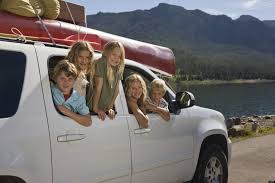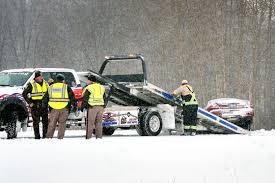Nothing says summer like a family road trip – Griswold-Style! Like most road trips, this post is long, but it’s full of valuable information on everything from vehicle preparation to passenger and driver safety.
So before you hit the road, take the time to review the National Highway Transportation Safety Administration’s tips for a safe summer road trip.
Prep Your Vehicle
Regular maintenance will go a long way toward preventing breakdowns. If your vehicle has been serviced according to the manufacturer’s recommendations, it should be in good condition to travel. If not—or you don’t know the service history of the vehicle you plan to drive—schedule a preventive maintenance checkup before you go.
Owners may not always know their recalled vehicle still needs to be repaired. NHTSA’s VIN Lookup Tool lets you enter a Vehicle Identification Number (VIN) to quickly learn if a specific vehicle has not been repaired as part of a safety recall in the last 15 years.
Regardless of how well you take care of your car, it’s important to perform the following basic safety checks before you go on a road trip:
Vehicle Safety Checklist
Tires — Air pressure, tread wear, spare
Check your vehicle’s tire inflation pressure at least once a month, when your tires are cold (sitting for at least 3 hours or more)—and don’t forget to check the spare. The correct pressure for your tires is listed on a label on the driver’s door pillar or doorframe or in the vehicle owner’s manual—the correct pressure for your vehicle is NOT the number listed on the tire itself. All tires naturally lose some air over time. In fact, underinflation is the leading cause of tire failure.
If the tire tread is worn down to 2/32 of an inch, it’s time to replace your tires. Use the built-in wear bar indicators or use the penny test to determine if it’s time to replace the tires. Place a penny in the tread with Lincoln’s head upside down. If you can see the top of Lincoln’s head, your vehicle needs new tires. If you find uneven wear across the tires’ tread, it means your tires need rotation and/or your wheels need to be aligned before you go.
Belts and Hoses — Condition and fittings
Look under the hood and inspect all belts and hoses to make sure there are no signs of bulges, blisters, cracks, or cuts in the rubber. High summer temperatures accelerate the rate at which rubber belts and hoses degrade. While you’re at it, check all hose connections to make sure they’re secure.
Wiper Blades — Wear and tear on both sides
After the heavy use from winter snow and spring rain, windshield wipers may need to be replaced. Examine your blades for signs of wear and tear. If they aren’t in top condition, invest in new ones before you go.
Cooling System — Coolant level and servicing
The radiator in your vehicle needs water and antifreeze (coolant) to keep your engine functioning properly. When your car hasn’t been running and the engine is completely cool, carefully check your coolant level to make sure the reservoir is full. In addition, if your coolant is clear, looks rusty, or has particles floating in it, it is time to have your cooling system flushed and refilled. If your coolant looks sludgy or oily, immediately take your vehicle to a mechanic.
Fluid Levels — Oil, brake, transmission, power steering, and windshield washer fluids
If it’s time or even nearly time to have the oil changed, now would be a good time to do it. In addition, check the following fluid levels: brake, automatic transmission or clutch, power steering, and windshield washer fluid. Make sure each reservoir is full; if you see any signs of fluid leakage, have your vehicle serviced.
Lights — Headlights, brake lights, turn signals, emergency flashers, interior lights, and trailer lights
See and be seen! Make sure all the lights on your vehicle are in working order. Check your headlights, brake lights, turn signals, emergency flashers, and interior lights. Towing a trailer? Be sure to also check your trailer including brake lights and turn signals. Trailer light connection failure is a common problem and a serious safety hazard.
Air Conditioning — A/C check
Check A/C performance before traveling. Lack of air conditioning on a hot summer day affects people who are in poor health or are sensitive to heat, such as children and older adults.
Protect the Children
Buckle up every time.
Everyone in your vehicle should be buckled up. Ensure all car seats and booster seats are properly installed and that any children riding with you are in the proper seat to best protect them. All children 13 and younger should ride in the back seat.
Go to NHTSA’s child passenger safety recommendations to find out how to select the right seat for your child’s age and size or to find a free inspection site near you.
Watch out for kids inside vehicles.
Hyperthermia or heatstroke can occur when a child is left unattended in a parked vehicle. Never leave children alone in the car—not even for a few minutes or with the engine running. Vehicles heat up quickly; if the outside temperature is in the low 80s°, the temperature inside the vehicle can reach deadly levels in just a few minutes – even with a window rolled down. A child’s body temperature rises 3 to 5 times faster than that of an adult.
Watch out for kids outside vehicles.
When children play, they are often oblivious to cars and trucks around them. They may believe that motorists will watch out for them. Before you back out of a driveway or parking spot, prevent backovers by walking around your vehicle to check for children. Be cognizant of blind spots. As the size and height of a vehicle increases, so does the blind zone area. Large vehicles, trucks, SUVs, RVs, and vans, are more likely than cars to be involved in backovers.
Lock your vehicle’s doors at all times when it’s not in use. Put the keys somewhere that children can’t get access to them. Children who enter vehicles on their own with no adult supervision can be killed or injured by power windows, seat belt entanglement, vehicle rollaway, heatstroke or trunk entrapment.
Visit www.safercar.gov/parents to find out more about how to keep children safe in and around cars.
Stay Alert!
Remember that long trips can be tough on children—so, in turn, tough on you. Plan enough time to stop along the way to stretch, get refreshments, return any calls/text messages, and change drivers if you’re feeling drowsy. Don’t push the distance you travel in one day. Instead, stay at a hotel or family resort for the night. Bring plenty of items that will keep kids content and occupied. This makes the trip seem faster and keeps you from being distracted every time they ask, “Are we there yet?”
Share the Road
Warmer weather attracts many types of roadway users, including motorcyclists, bicyclists, and pedestrians. While they have the same rights, privileges and responsibilities as every motorist, these road users are more vulnerable because they do not have the same protection.
Allow more distance between your vehicle and a motorcycle, as motorcycle are lighter and require less distance to stop.
Always signal your intentions before changing lanes or merging with traffic. This allows other road users to anticipate your movement and find a safe lane position.
Be mindful of pedestrians:
- You can encounter pedestrians anytime and anywhere.
- Do not assume that pedestrians can see you or that they will act predictably. They may be distracted, or physically or mentally impaired.
- Pedestrians can be very hard to see – especially in bad weather or at night.
- Stop for pedestrians who are in a crosswalk, even if it’s not marked. This will help drivers in the other lanes see the pedestrian in time to stop.
- Cars stopped in the street may be stopped to allow pedestrians to cross. Do not pass if there is any doubt.
- When you are turning and waiting for a “gap” in traffic, watch for pedestrians who may have moved into your intended path.
- Be especially attentive around schools and in neighborhoods where children are active.
Avoid Bad Driving Behaviors
Distracted Driving
Distracted driving is anything that takes your attention away from driving, such as cell phone use, texting while driving, eating, drinking, setting the GPS, talking with passengers, and using in-vehicle technologies and portable electronic devices. No one’s lives are worth a phone call or text. Plus, law enforcement officers across the Nation are now using innovative strategies to aggressively enforce their State distracted driving laws.
Set specific driving rules with your co-drivers before you hit the road. These rules should include refraining from activities that take your eyes and attention off the road. Enlist the help of passengers for getting directions, setting the GPS, and making/returning calls or texts. Go to EndDD.org to download a family safe driving agreement that you and your co-drivers can sign together.
Impaired Driving
Alcohol and drugs can impair perception, judgment, motor skills, and memory – the skills critical for safe and responsible driving. Impaired driving not only puts the driver at risk – it threatens the lives of passengers and all others who share the road. Be responsible; don’t drink and drive. Illegal drugs, as well as prescription and over-the-counter medications, can be just as deadly on the road as alcohol. If you plan to drink, designate a sober driver or use a cab to get home safely.
The NHTSA’s new SaferRide app allows users to call a cab or friend for a ride, and will even help users identify their location so they can be picked up. Download the app from the iTunes store or Google Play.
Remember, getting there is half the fun! Please drive safely.










